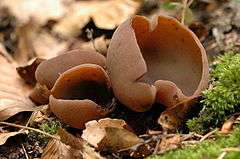Pezizaceae
| Cup fungi | |
|---|---|
 | |
| Peziza badia | |
| Scientific classification | |
| Kingdom: | Fungi |
| Division: | Ascomycota |
| Class: | Pezizomycetes |
| Order: | Pezizales |
| Family: | Pezizaceae Dumort. (1829) |
| Type genus | |
| Peziza Dill. ex Fr. (1822) | |
| Genera | |
|
See text | |
The Pezizaceae (commonly referred to as cup fungi) are a family of fungi in the Ascomycota which produce mushrooms that tends to grow in the shape of a "cup". Spores are formed on the inner surface of the fruit body (mushroom). The cup shape typically serves to focus raindrops into splashing spores out of the cup. Additionally, the curvature enables wind currents to blow the spores out in a different manner than in most agarics and boletes.
Cup fungi grow in peculiar shapes, frequently resembling cups or saucers. For example, the orange peel fungus (Aleuria aurantia) resembles a discarded orange rind. They may be vividly colored, like the scarlet cup (Sarcoscypha coccinea), which is often one of the first signs of spring where it grows. According to one 2008 estimate, the family contains 31 genera and 230 species.[1]
Genera list
- Amylascus
- Aquapeziza
- Boudiera
- Cazia
- Eremiomyces
- Hapsidomyces
- Hydnobolites
- Hydnotryopsis
- Iodophanus
- Iodowynnea
- Kalaharituber
- Lepidotia
- Marcelleina
- Mattiroliomyces
- Mycoclelandia
- Pachyella
- Pachyphloeus
- Peziza
- Plicaria
- Rhodopeziza
- Ruhlandiella
- Sarcosphaera
- Scabropezia
- Sphaerozone
- Terfezia
- Tirmania
References
| Wikispecies has information related to: Pezizaceae |